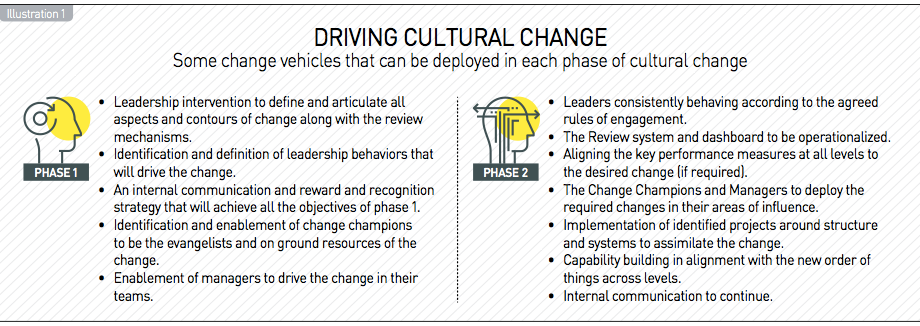Systemic approach to cultural transformation

A systemic approach to cultural transformation inherently holds the promise of sustainable results. It is like stating the obvious. Why then, is it almost as mythical as a unicorn for most organizations? Why then, do most culture-related studies report depressing rates of success for major culture change initiatives globally?The good news is that along with the dreary statistics of failed cultural transformations, there are also success stories that indicate light at the end of the tunnel and offer an assurance that successful cultural transformation is in the realm of possibility! All that is then required is to intensely observe what these organizations have done and then contextualize those best practices to our environment. At the outset, one common element that stands out in successful cultural transformation stories is the systemic approach that organizations adopt to transform their cultures. Let’s therefore attempt to demystify “cultural transformation” and “systemic” approach.
The first and probably the most critical observation is that the need for cultural transformation should always stem from a clear business imperative. Once the business context is clearly articulated and the measures it is expected to impact are compelling, it moves into the radar of the leadership team, which then ensures that some of the building blocks of a systemic approach are in place. The leadership team the drives this as a key priority; it gets called out as a “must do” as against “a good to do” strategic initiative and finally it is communicated as an inherent part of everyone’s day job and not something that must be done in addition to the day job.
There is no one sure shot prescribed approach to how culture change can be successfully implemented in any organization
In this article, we look at answers to some of the key questions that arise during cultural transformation and a four-step guide to bring cultural transformation.
What situations or business reasons merit an initiative as momentous as culturally transforming an entire organization?
This one is an easy one to answer — any transformation that is triggered by goals of survival, staying relevant or growth. These could be driven by any of the following scenarios:
- A growing gap between the promised customer value proposition and the actual customer experience.
- Changing customer expectations because of the competitive landscape, customer demographic, regulatory and technological changes etc.
These may then lead to the following scenarios:
- Established brands shedding legacy to meet the changing customer profiles and expectations
- Mergers and acquisitions
- Matrix structures and integration at regional or global levels
- Organizations aligning their product and service delivery to customer expectations
- Rearticulating and redeploying the vision ensures relevance and growth
Being alert to customer preferences and then responding to them with alacrity are essential to remaining relevant and to grow. Organizations that are able to constantly curate or transform their cultures in line with the customers’ needs and the customer value proposition have survived and flourished over time.
Once the business imperative for a cultural transformation is established, the next question to be answered is:
Why is a systemic approach to culture transformation required?
Aristotle said, “We are what we repeatedly do.” And this can be extrapolated to organizations too. An organization’s culture is consistent, observable patterns of behavior in organizations “the way things are done in the organization”. Most organizations while looking to grow or to transform tend to consider and deploy “quick fix” solutions, which may not address “the way things are done” in the organization. The normal recourse is to implement a change strategy that emphasizes restructuring or revamping systems or inducting resources. However, research and our experience indicate that these initiatives are unsustainable if not supported by core changes in the culture – “the way things are done in the organization”.
These core changes have to be led by leaders with an unflinching intent to drive the transformation and leaders who are able to create an aligned ecosystem and are able to inspire people to commit to the change with their “hearts and minds”.
“Culture transformation solutions have to involve the alignment of the desired state to the strategy, leadership behaviors and signals, hearts and minds of people, and the structures and systems.”
Finally, the question to be addressed is:
How should organizations strategize for systemic cultural transformation?
There is no cookie cutter approach to cultural transformation. The word “culture” means that each organization will have multiple and unique nuances. Therefore, applying best practices without making them relevant to the specific cultural nuances is like performing the same medical procedure for different aliments just because it was successful for some ailment.
Organizations that are able to constantl curate or transform their cultures in line with the customers’ needs and the customer value proposition have survived and flourished over time
How can one ensure successful and sustainable impact?
A Three-step guideline
The below three-step guideline should be considered by any organization or change leader(s) to bring about change.
1. Clearly communicate the change imperative or “why” the change is required in the entire organization.
What is the business imperative that is driving this change? How it will impact the business & how will the organization know that it has successfully changed? Establishing the raison d'être of the impending change is the most critical step. Unless there are clear answers to these questions, the answers to ‘what needs to change organizationally’ will not be clear and people will not know “what they have to change” and the consequence of not changing will be blurred as well.
Elucidating by an example – the mandate for a multinational pharmaceutical organization was to “integrate the Indian operations with the global way of working” that was based on the business need to create globally relevant and standardized quality of products. Hitherto, India like other markets had operated in the limited space of producing in India for India. Now the mandate was to create a Global Supply Chain for the global market. This required transforming the “way things were done” in the India plants. The first step therefore entailed clearly articulating and communicating answers to questions such as – ‘Why is this required?’, ‘What will we achieve?’, ‘What will be the business impact?’ The global, regional and local leaders needed to communicate these answers together to the entire workforce in India. The effort to get them to communicate these answers ensured that all the relevant stakeholders got involved, put their stakes in the ground, agreed on the measures to be impacted and therefore also committed their time to the process of change – which most would agree, is the first sign of success.
2. Leadership Readiness: Are the business leaders equipped and committed to drive that change?
Let there be no doubt, business leaders are responsible for cultural transformation. HR and OD leaders provide change expertise but change has to be driven by business leaders. Leaders, at the minimum, have to perform the following to successfully lead cultural transformation:
- Ensure that the measures of success and the review dashboards reflect the desired change.
- Clearly articulate and communicate what they will be doing differently to bring about the culture transformation. Some critical leadership behaviors have to change to signal the credibility of the initiative.
- Role model the desired behaviors at all times.
- Create an ecosystem of communication and formal and informal rewards and recognition that encourage the display of desired behaviors and manage consequences when not displayed.
If there is even the slightest hesitation or ambiguity in committing to any of these, it may not be a good time to implement change. It may be better to maintain status quo, than to do it inconsistently or tactically and cause more damage.
3. The ‘culture change’ implementation strategy
There is no one sure shot prescribed approach to how culture change can be successfully implemented in any organization. This is because the elements and drivers in each culture are different and hence what works in every organization is unique to that organization.
A few factors that may, however, help decide the course of action include the details of leadership style, things that have worked in the past, ways of working, drivers of change and helping and hindering factors. All of these and more can be established through qualitative diagnostics study that includes leadership interviews, FGDs across the organization, observations, mystery audits et al. These results would help design the change strategy that is completely contextualized to the organization.
One common element that stands out in successful cultural transformation stories is the systemic approach that organizations have adopted to transform their cultures
Phases of cultural change

Deploying change culturally has two major phases with distinct objectives:
1. The initial phase
In this phase, the objective is to build:
- Clarity about what has to change, how it will be done, and the role everyone in the organization has to play.
- Inspiration, energy and momentum required to engage the larger audience with the change and commit to it.
- Credibility and seriousness of intent of the initiative through strong visible leadership signals.
2. The “this is the way of life ” phase
In this phase, the objective is to build:
- Integrate the new order of things as the way of life.
- To ensure that the entire ecosystem of signals, skills, behaviors, structure and systems is aligned to the desired change.
Read about the change tools/vehicles you can use for each phase in illustration 1
What is critical is to work towards a systemic & a customized plan to increase the chances of acceptance, adaptation and successful implementation of change towards business impact. The implication of basing the strategy on a diagnostics is the tools, methods and strategies that will be put in place will also be unique. So, for instance in some cases a successful strategy may involve a high energy organization wide communication whirlwind led by hugely inspirational leaders; however, in an organization where the leaders are intrinsically not so inspirational, this may not work and deploying other best practices like linking the required change to the way people will grow in the company may work better. In some organizations, empowering and equipping all the managers to be the flag bearers and enablers of change will work, while in some others identifying change champions across levels will work better. And in some others, just changing the way “good performance is defined and measured” at organizational, team and individual levels may create the desired change.
CONCLUSION
The formula to successful culture transformation lies in organizations being able to do four things. First, have clarity on why the transformation is necessary – the business imperative and measures. Second, the leaders have to own the role of driving the change by aligning their behaviors to the change and creating the ecosystem conducive to people engaging with the culture change. Third, the approach has to be systemic, and it has to impact “the way things are done” i.e. incorporate all elements of the culture. And fourth, it must be contextualized to the organization through a deeply insightful diagnostics across all cultural elements.











